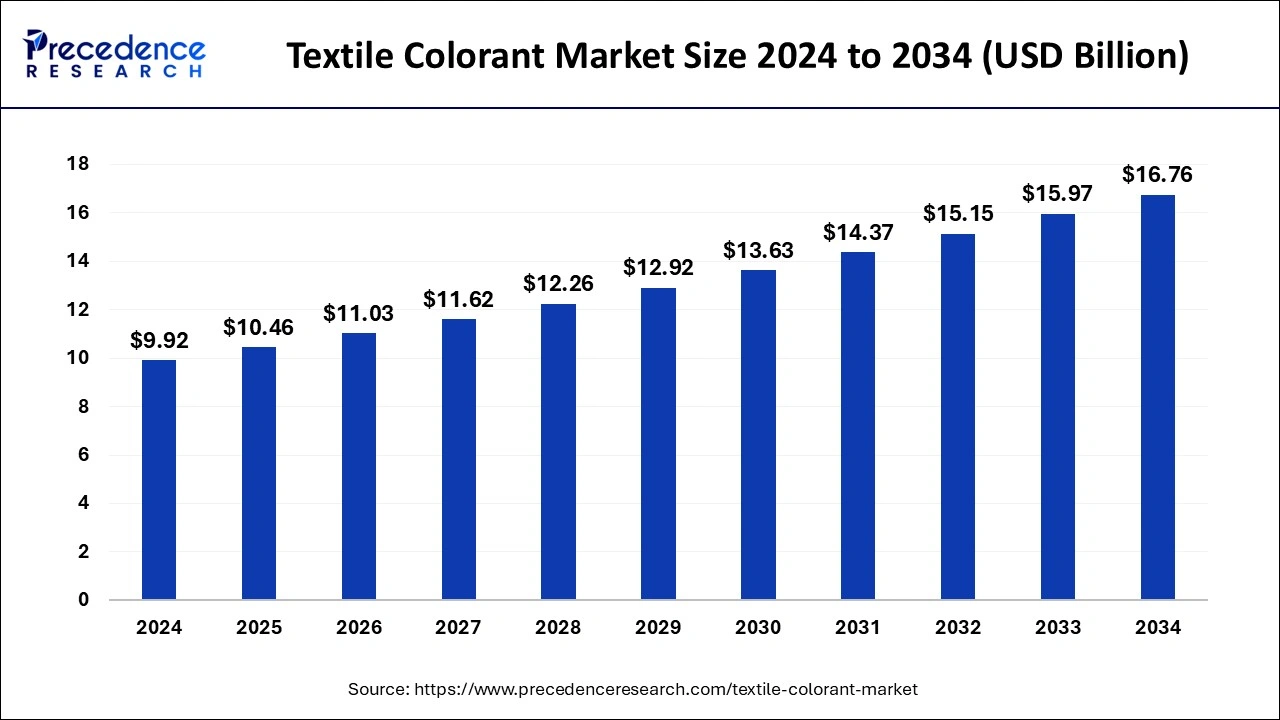- North America dominated the market with the largest market share of 34% in 2023.
- Asia Pacific is expected to grow significantly during the forecast period.
- By dye type, the dispersed dye segment has held the biggest market share of 24% in 2023.
- By pigment type, the inorganic pigment segment dominated the market with the major revenue share of 57% in 2023.
- By End use, the textile and apparel industry segment has contributed the largest market share in 2023.

Get a Sample: https://www.precedenceresearch.com/sample/4010
One of the primary growth factors driving the textile colorant market is the booming textile industry worldwide. The growing population, rising disposable income, and changing fashion trends have led to increased consumption of textiles across various end-use sectors. As a result, textile manufacturers are constantly seeking innovative and high-quality colorant solutions to meet the evolving demands of consumers. This has spurred the demand for advanced textile colorants that offer superior color fastness, durability, and eco-friendliness.
Regionally, Asia Pacific has emerged as a dominant market for textile colorants, owing to the presence of key textile manufacturing hubs such as China, India, Bangladesh, and Vietnam. These countries are major producers and exporters of textiles, catering to both domestic and international markets. The rapid industrialization, favorable government policies, and abundant availability of raw materials in the region further contribute to the growth of the textile colorant market in Asia Pacific.
Textile Colorant Market Scope
| Report Coverage | Details |
| Growth Rate from 2024 to 2033 | CAGR of 5.44% |
| Global Market Size in 2023 | USD 9.41 Billion |
| Global Market Size by 2033 | USD 15.97 Billion |
| U.S. Market Size in 2023 | USD 2.40 Billion |
| U.S. Market Size by 2033 | USD 4.07 Billion |
| Base Year | 2023 |
| Forecast Period | 2024 to 2033 |
| Segments Covered | By Dye Type, By Pigment Type, and By End User |
| Regions Covered | North America, Europe, Asia-Pacific, Latin America, and Middle East & Africa |
Textile Colorant Market Dynamics
The textile colorant market is driven by several factors, including technological advancements in colorant formulations, increasing adoption of sustainable and eco-friendly colorants, and growing demand for functional textiles with special properties such as UV resistance, antimicrobial properties, and moisture management. Manufacturers are investing in research and development activities to introduce innovative colorant solutions that meet the evolving needs of the textile industry while adhering to stringent environmental regulations.
Moreover, the textile colorant market offers abundant opportunities for growth and expansion, particularly in emerging markets where rapid urbanization and industrialization are driving the demand for textiles. Additionally, the growing awareness among consumers regarding sustainable and eco-friendly products is fueling the demand for natural and bio-based colorants derived from renewable sources such as plants, fruits, and vegetables.
Despite the favorable growth prospects, the textile colorant market faces certain challenges that may hinder its growth trajectory. These challenges include fluctuating prices of raw materials, stringent regulatory requirements regarding the use of certain chemicals in textile processing, and environmental concerns associated with the disposal of textile waste and chemical pollutants. Manufacturers are under pressure to develop innovative and sustainable colorant solutions that minimize the environmental impact and meet the stringent regulatory standards imposed by governing bodies.
Read Also: Space Robotics Market Size to Touch USD 11.23 Bn by 2033
Recent Developments
- In April 2023, Textile digital printing has advanced significantly in recent years thanks to the development of new printers and inks that push the boundaries of technology. Epson, a significant player in the textile industry, is one of the businesses setting the standard for innovation. Epson has unveiled the SureColor® F2270, a hybrid printer, as its newest offering in the digital textile printing market.
- In February 2023, Archroma acquired Huntsman Corporation’s Textile Effects. This move will help Archroma enhance its existing business. The company is set to form a new division known as Archroma Textile Effects.
Textile Colorant Market Companies
- Huntsman Corporation
- Archroma
- BASF SE
- Lanxess AG
- Kiri Industries
- Sumitomo Chemical Co., Ltd
- Dystar Group
- KRONOS
Segment Covered in the Report
By Dye Type
- Acid Dyes
- Basic Dyes
- Direct Dyes
- Disperse Dyes
- Reactive Dyes
By Pigment Type
- Organic Pigment
- Inorganic Pigment
By End User
- Textile and Apparel Industry
- Home Furnishing Industry
- Automotive Industry
- Healthcare Industry
- Others
By Geography
- North America
- Europe
- Asia-Pacific
- Latin America
- Middle East and Africa
Contact Us:
Mr. Alex
Sales Manager
Call: +1 9197 992 333
Email: sales@precedenceresearch.com
Web: https://www.precedenceresearch.com
Blog: https://www.expresswebwire.com/
Blog: https://www.uswebwire.com/
